Report: Steps for Integrating Evidence-Based Practices in Nursing
VerifiedAdded on 2022/12/26
|11
|2733
|93
Report
AI Summary
This report provides a comprehensive overview of integrating evidence-based practices (EBP) into clinical settings. It outlines the eight crucial steps involved, starting with formulating clinical questions using the PICOT framework, searching for and gathering evidence from reliable sources, critically appraising the evidence, implementing the findings, evaluating the outcomes, integrating the evidence with clinical experience and patient preferences, and finally, disseminating the results. The report also identifies significant barriers to EBP implementation, such as professional incompetence, lack of skills in searching for relevant sources, lack of experience, and scarcity of essential resources. Furthermore, it suggests strategies to overcome these barriers, including utilizing available resources, introducing induction programs, and encouraging teamwork. The report also highlights six sources of internal evidence that can improve patient outcomes: empirical, ethical, personal experience, aesthetic, economic, and health impact assessments. The successful integration of EBP is crucial for enhancing the quality of healthcare, improving patient outcomes, providing crucial information for nursing practice, and reducing healthcare costs.

Integration of Evidence-Based Practices
Student’s Name
Institution’s Affiliations
Date
Student’s Name
Institution’s Affiliations
Date
Paraphrase This Document
Need a fresh take? Get an instant paraphrase of this document with our AI Paraphraser
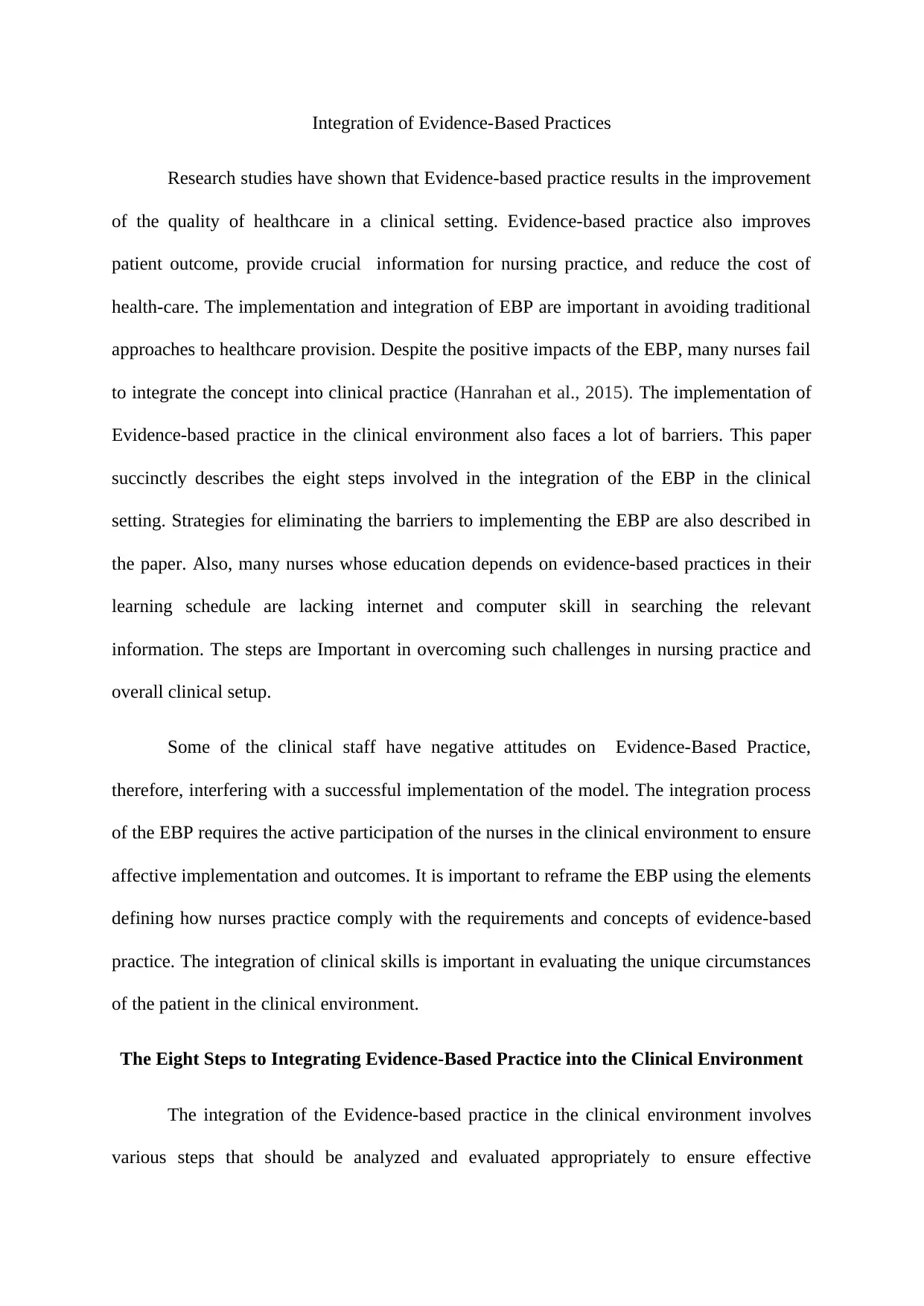
Integration of Evidence-Based Practices
Research studies have shown that Evidence-based practice results in the improvement
of the quality of healthcare in a clinical setting. Evidence-based practice also improves
patient outcome, provide crucial information for nursing practice, and reduce the cost of
health-care. The implementation and integration of EBP are important in avoiding traditional
approaches to healthcare provision. Despite the positive impacts of the EBP, many nurses fail
to integrate the concept into clinical practice (Hanrahan et al., 2015). The implementation of
Evidence-based practice in the clinical environment also faces a lot of barriers. This paper
succinctly describes the eight steps involved in the integration of the EBP in the clinical
setting. Strategies for eliminating the barriers to implementing the EBP are also described in
the paper. Also, many nurses whose education depends on evidence-based practices in their
learning schedule are lacking internet and computer skill in searching the relevant
information. The steps are Important in overcoming such challenges in nursing practice and
overall clinical setup.
Some of the clinical staff have negative attitudes on Evidence-Based Practice,
therefore, interfering with a successful implementation of the model. The integration process
of the EBP requires the active participation of the nurses in the clinical environment to ensure
affective implementation and outcomes. It is important to reframe the EBP using the elements
defining how nurses practice comply with the requirements and concepts of evidence-based
practice. The integration of clinical skills is important in evaluating the unique circumstances
of the patient in the clinical environment.
The Eight Steps to Integrating Evidence-Based Practice into the Clinical Environment
The integration of the Evidence-based practice in the clinical environment involves
various steps that should be analyzed and evaluated appropriately to ensure effective
Research studies have shown that Evidence-based practice results in the improvement
of the quality of healthcare in a clinical setting. Evidence-based practice also improves
patient outcome, provide crucial information for nursing practice, and reduce the cost of
health-care. The implementation and integration of EBP are important in avoiding traditional
approaches to healthcare provision. Despite the positive impacts of the EBP, many nurses fail
to integrate the concept into clinical practice (Hanrahan et al., 2015). The implementation of
Evidence-based practice in the clinical environment also faces a lot of barriers. This paper
succinctly describes the eight steps involved in the integration of the EBP in the clinical
setting. Strategies for eliminating the barriers to implementing the EBP are also described in
the paper. Also, many nurses whose education depends on evidence-based practices in their
learning schedule are lacking internet and computer skill in searching the relevant
information. The steps are Important in overcoming such challenges in nursing practice and
overall clinical setup.
Some of the clinical staff have negative attitudes on Evidence-Based Practice,
therefore, interfering with a successful implementation of the model. The integration process
of the EBP requires the active participation of the nurses in the clinical environment to ensure
affective implementation and outcomes. It is important to reframe the EBP using the elements
defining how nurses practice comply with the requirements and concepts of evidence-based
practice. The integration of clinical skills is important in evaluating the unique circumstances
of the patient in the clinical environment.
The Eight Steps to Integrating Evidence-Based Practice into the Clinical Environment
The integration of the Evidence-based practice in the clinical environment involves
various steps that should be analyzed and evaluated appropriately to ensure effective
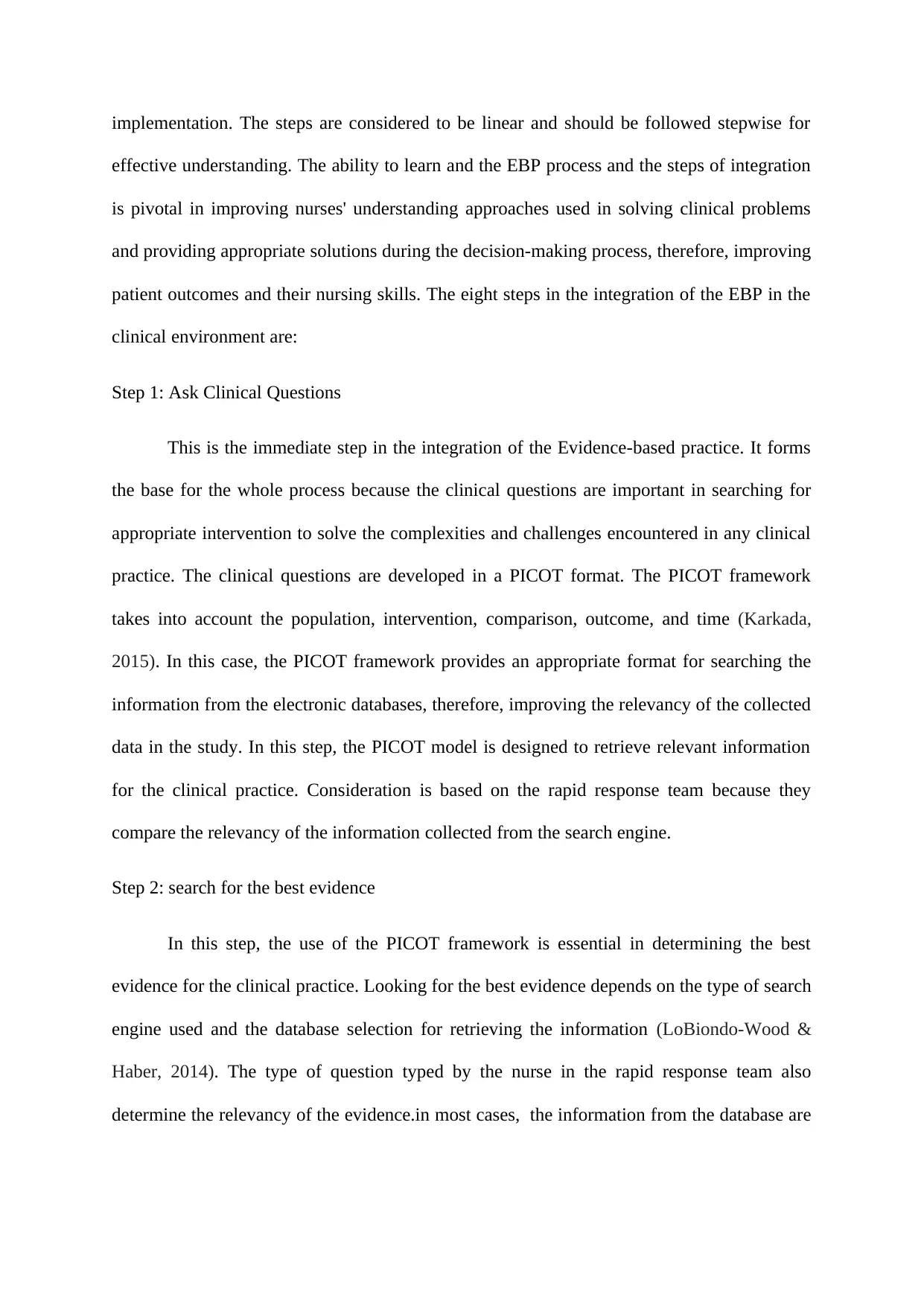
implementation. The steps are considered to be linear and should be followed stepwise for
effective understanding. The ability to learn and the EBP process and the steps of integration
is pivotal in improving nurses' understanding approaches used in solving clinical problems
and providing appropriate solutions during the decision-making process, therefore, improving
patient outcomes and their nursing skills. The eight steps in the integration of the EBP in the
clinical environment are:
Step 1: Ask Clinical Questions
This is the immediate step in the integration of the Evidence-based practice. It forms
the base for the whole process because the clinical questions are important in searching for
appropriate intervention to solve the complexities and challenges encountered in any clinical
practice. The clinical questions are developed in a PICOT format. The PICOT framework
takes into account the population, intervention, comparison, outcome, and time (Karkada,
2015). In this case, the PICOT framework provides an appropriate format for searching the
information from the electronic databases, therefore, improving the relevancy of the collected
data in the study. In this step, the PICOT model is designed to retrieve relevant information
for the clinical practice. Consideration is based on the rapid response team because they
compare the relevancy of the information collected from the search engine.
Step 2: search for the best evidence
In this step, the use of the PICOT framework is essential in determining the best
evidence for the clinical practice. Looking for the best evidence depends on the type of search
engine used and the database selection for retrieving the information (LoBiondo-Wood &
Haber, 2014). The type of question typed by the nurse in the rapid response team also
determine the relevancy of the evidence.in most cases, the information from the database are
effective understanding. The ability to learn and the EBP process and the steps of integration
is pivotal in improving nurses' understanding approaches used in solving clinical problems
and providing appropriate solutions during the decision-making process, therefore, improving
patient outcomes and their nursing skills. The eight steps in the integration of the EBP in the
clinical environment are:
Step 1: Ask Clinical Questions
This is the immediate step in the integration of the Evidence-based practice. It forms
the base for the whole process because the clinical questions are important in searching for
appropriate intervention to solve the complexities and challenges encountered in any clinical
practice. The clinical questions are developed in a PICOT format. The PICOT framework
takes into account the population, intervention, comparison, outcome, and time (Karkada,
2015). In this case, the PICOT framework provides an appropriate format for searching the
information from the electronic databases, therefore, improving the relevancy of the collected
data in the study. In this step, the PICOT model is designed to retrieve relevant information
for the clinical practice. Consideration is based on the rapid response team because they
compare the relevancy of the information collected from the search engine.
Step 2: search for the best evidence
In this step, the use of the PICOT framework is essential in determining the best
evidence for the clinical practice. Looking for the best evidence depends on the type of search
engine used and the database selection for retrieving the information (LoBiondo-Wood &
Haber, 2014). The type of question typed by the nurse in the rapid response team also
determine the relevancy of the evidence.in most cases, the information from the database are
⊘ This is a preview!⊘
Do you want full access?
Subscribe today to unlock all pages.

Trusted by 1+ million students worldwide
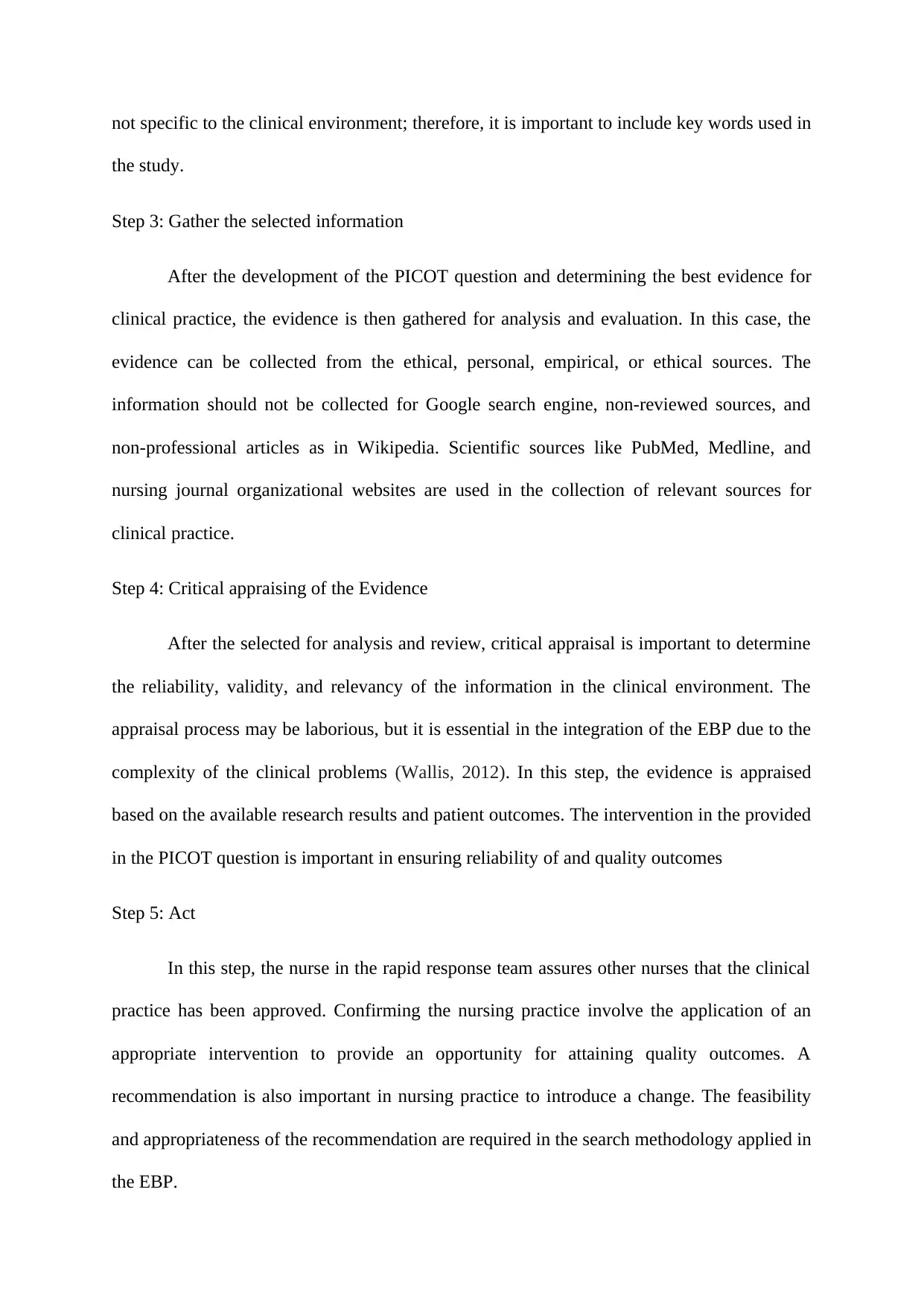
not specific to the clinical environment; therefore, it is important to include key words used in
the study.
Step 3: Gather the selected information
After the development of the PICOT question and determining the best evidence for
clinical practice, the evidence is then gathered for analysis and evaluation. In this case, the
evidence can be collected from the ethical, personal, empirical, or ethical sources. The
information should not be collected for Google search engine, non-reviewed sources, and
non-professional articles as in Wikipedia. Scientific sources like PubMed, Medline, and
nursing journal organizational websites are used in the collection of relevant sources for
clinical practice.
Step 4: Critical appraising of the Evidence
After the selected for analysis and review, critical appraisal is important to determine
the reliability, validity, and relevancy of the information in the clinical environment. The
appraisal process may be laborious, but it is essential in the integration of the EBP due to the
complexity of the clinical problems (Wallis, 2012). In this step, the evidence is appraised
based on the available research results and patient outcomes. The intervention in the provided
in the PICOT question is important in ensuring reliability of and quality outcomes
Step 5: Act
In this step, the nurse in the rapid response team assures other nurses that the clinical
practice has been approved. Confirming the nursing practice involve the application of an
appropriate intervention to provide an opportunity for attaining quality outcomes. A
recommendation is also important in nursing practice to introduce a change. The feasibility
and appropriateness of the recommendation are required in the search methodology applied in
the EBP.
the study.
Step 3: Gather the selected information
After the development of the PICOT question and determining the best evidence for
clinical practice, the evidence is then gathered for analysis and evaluation. In this case, the
evidence can be collected from the ethical, personal, empirical, or ethical sources. The
information should not be collected for Google search engine, non-reviewed sources, and
non-professional articles as in Wikipedia. Scientific sources like PubMed, Medline, and
nursing journal organizational websites are used in the collection of relevant sources for
clinical practice.
Step 4: Critical appraising of the Evidence
After the selected for analysis and review, critical appraisal is important to determine
the reliability, validity, and relevancy of the information in the clinical environment. The
appraisal process may be laborious, but it is essential in the integration of the EBP due to the
complexity of the clinical problems (Wallis, 2012). In this step, the evidence is appraised
based on the available research results and patient outcomes. The intervention in the provided
in the PICOT question is important in ensuring reliability of and quality outcomes
Step 5: Act
In this step, the nurse in the rapid response team assures other nurses that the clinical
practice has been approved. Confirming the nursing practice involve the application of an
appropriate intervention to provide an opportunity for attaining quality outcomes. A
recommendation is also important in nursing practice to introduce a change. The feasibility
and appropriateness of the recommendation are required in the search methodology applied in
the EBP.
Paraphrase This Document
Need a fresh take? Get an instant paraphrase of this document with our AI Paraphraser
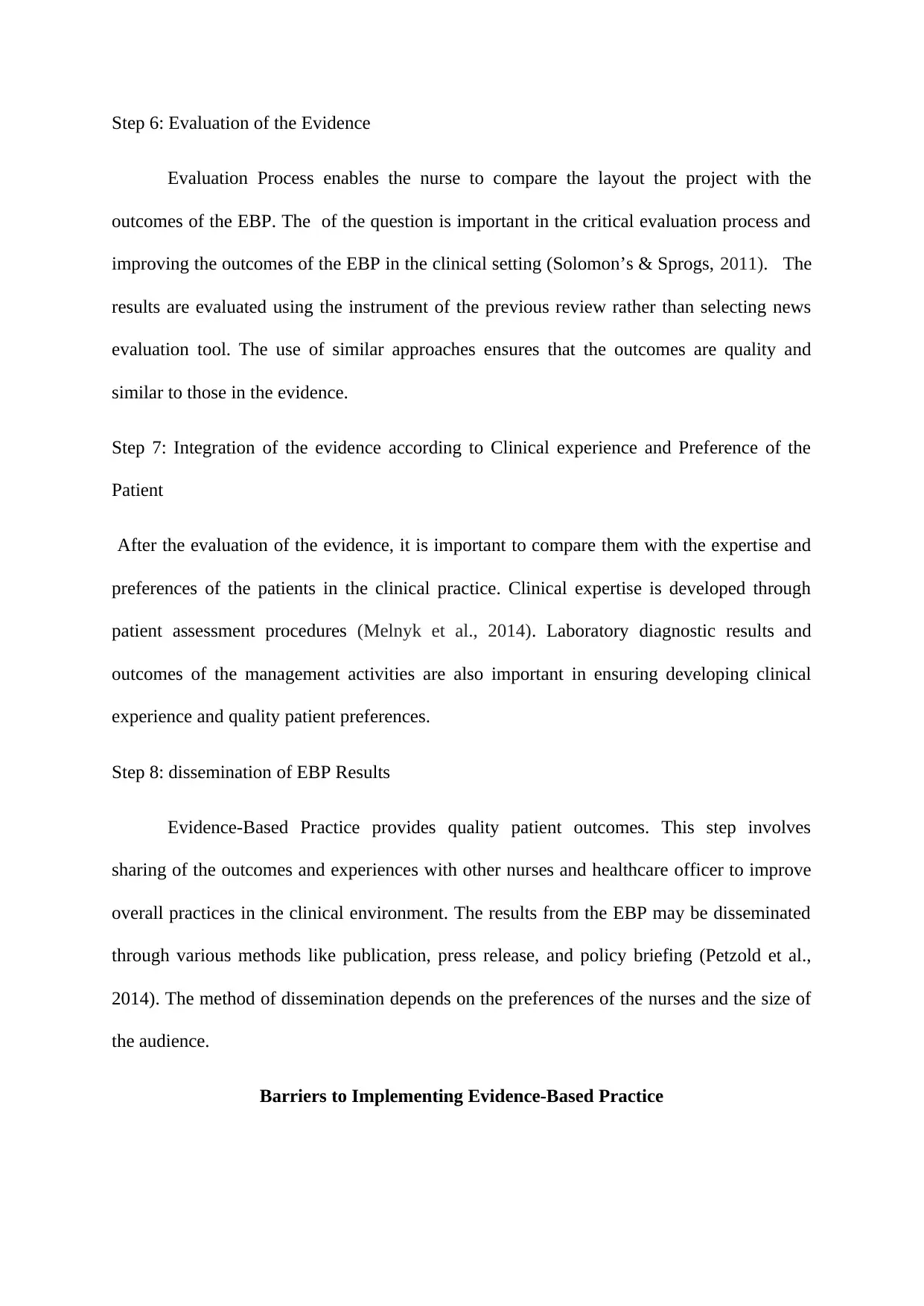
Step 6: Evaluation of the Evidence
Evaluation Process enables the nurse to compare the layout the project with the
outcomes of the EBP. The of the question is important in the critical evaluation process and
improving the outcomes of the EBP in the clinical setting (Solomon’s & Sprogs, 2011). The
results are evaluated using the instrument of the previous review rather than selecting news
evaluation tool. The use of similar approaches ensures that the outcomes are quality and
similar to those in the evidence.
Step 7: Integration of the evidence according to Clinical experience and Preference of the
Patient
After the evaluation of the evidence, it is important to compare them with the expertise and
preferences of the patients in the clinical practice. Clinical expertise is developed through
patient assessment procedures (Melnyk et al., 2014). Laboratory diagnostic results and
outcomes of the management activities are also important in ensuring developing clinical
experience and quality patient preferences.
Step 8: dissemination of EBP Results
Evidence-Based Practice provides quality patient outcomes. This step involves
sharing of the outcomes and experiences with other nurses and healthcare officer to improve
overall practices in the clinical environment. The results from the EBP may be disseminated
through various methods like publication, press release, and policy briefing (Petzold et al.,
2014). The method of dissemination depends on the preferences of the nurses and the size of
the audience.
Barriers to Implementing Evidence-Based Practice
Evaluation Process enables the nurse to compare the layout the project with the
outcomes of the EBP. The of the question is important in the critical evaluation process and
improving the outcomes of the EBP in the clinical setting (Solomon’s & Sprogs, 2011). The
results are evaluated using the instrument of the previous review rather than selecting news
evaluation tool. The use of similar approaches ensures that the outcomes are quality and
similar to those in the evidence.
Step 7: Integration of the evidence according to Clinical experience and Preference of the
Patient
After the evaluation of the evidence, it is important to compare them with the expertise and
preferences of the patients in the clinical practice. Clinical expertise is developed through
patient assessment procedures (Melnyk et al., 2014). Laboratory diagnostic results and
outcomes of the management activities are also important in ensuring developing clinical
experience and quality patient preferences.
Step 8: dissemination of EBP Results
Evidence-Based Practice provides quality patient outcomes. This step involves
sharing of the outcomes and experiences with other nurses and healthcare officer to improve
overall practices in the clinical environment. The results from the EBP may be disseminated
through various methods like publication, press release, and policy briefing (Petzold et al.,
2014). The method of dissemination depends on the preferences of the nurses and the size of
the audience.
Barriers to Implementing Evidence-Based Practice
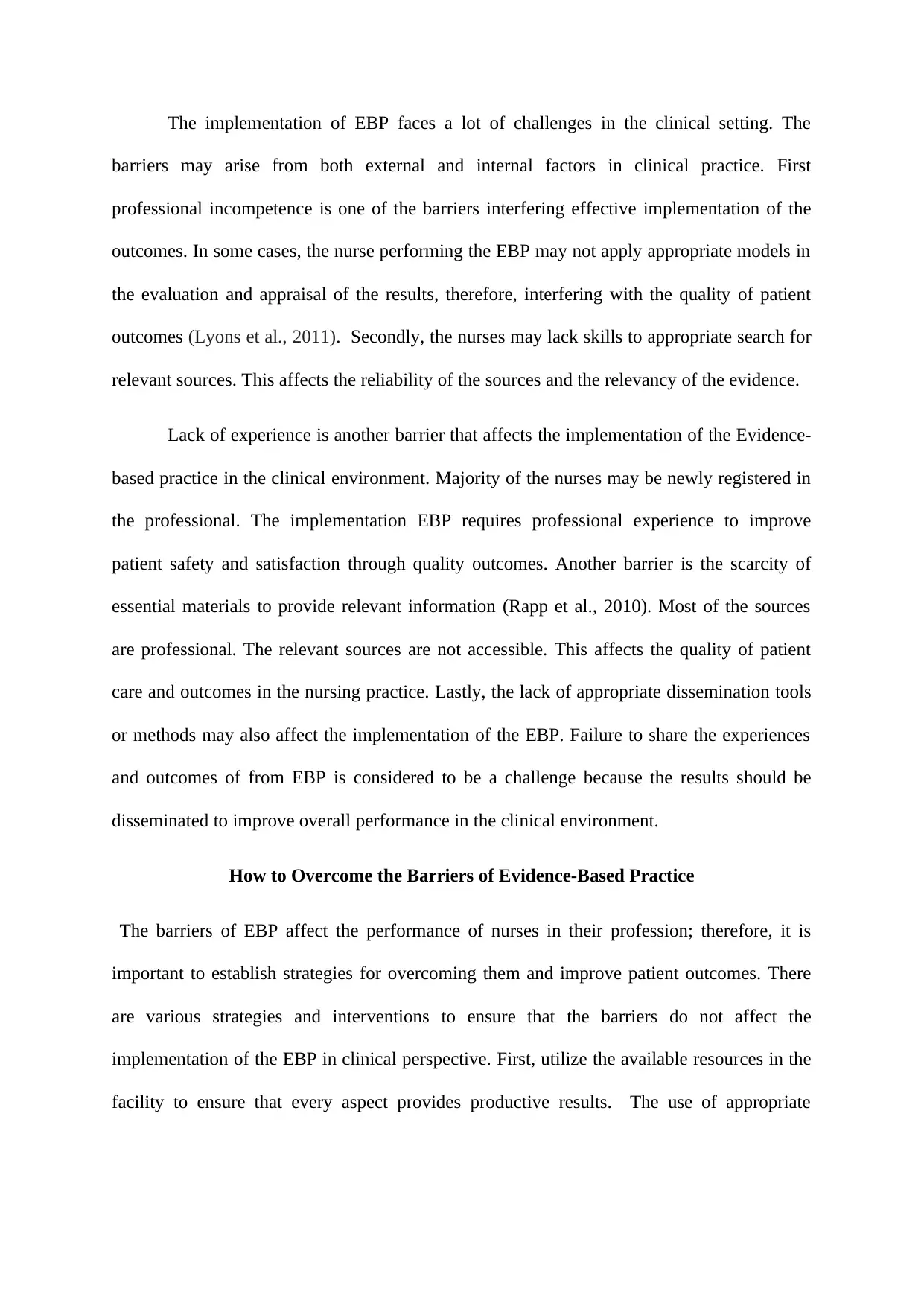
The implementation of EBP faces a lot of challenges in the clinical setting. The
barriers may arise from both external and internal factors in clinical practice. First
professional incompetence is one of the barriers interfering effective implementation of the
outcomes. In some cases, the nurse performing the EBP may not apply appropriate models in
the evaluation and appraisal of the results, therefore, interfering with the quality of patient
outcomes (Lyons et al., 2011). Secondly, the nurses may lack skills to appropriate search for
relevant sources. This affects the reliability of the sources and the relevancy of the evidence.
Lack of experience is another barrier that affects the implementation of the Evidence-
based practice in the clinical environment. Majority of the nurses may be newly registered in
the professional. The implementation EBP requires professional experience to improve
patient safety and satisfaction through quality outcomes. Another barrier is the scarcity of
essential materials to provide relevant information (Rapp et al., 2010). Most of the sources
are professional. The relevant sources are not accessible. This affects the quality of patient
care and outcomes in the nursing practice. Lastly, the lack of appropriate dissemination tools
or methods may also affect the implementation of the EBP. Failure to share the experiences
and outcomes of from EBP is considered to be a challenge because the results should be
disseminated to improve overall performance in the clinical environment.
How to Overcome the Barriers of Evidence-Based Practice
The barriers of EBP affect the performance of nurses in their profession; therefore, it is
important to establish strategies for overcoming them and improve patient outcomes. There
are various strategies and interventions to ensure that the barriers do not affect the
implementation of the EBP in clinical perspective. First, utilize the available resources in the
facility to ensure that every aspect provides productive results. The use of appropriate
barriers may arise from both external and internal factors in clinical practice. First
professional incompetence is one of the barriers interfering effective implementation of the
outcomes. In some cases, the nurse performing the EBP may not apply appropriate models in
the evaluation and appraisal of the results, therefore, interfering with the quality of patient
outcomes (Lyons et al., 2011). Secondly, the nurses may lack skills to appropriate search for
relevant sources. This affects the reliability of the sources and the relevancy of the evidence.
Lack of experience is another barrier that affects the implementation of the Evidence-
based practice in the clinical environment. Majority of the nurses may be newly registered in
the professional. The implementation EBP requires professional experience to improve
patient safety and satisfaction through quality outcomes. Another barrier is the scarcity of
essential materials to provide relevant information (Rapp et al., 2010). Most of the sources
are professional. The relevant sources are not accessible. This affects the quality of patient
care and outcomes in the nursing practice. Lastly, the lack of appropriate dissemination tools
or methods may also affect the implementation of the EBP. Failure to share the experiences
and outcomes of from EBP is considered to be a challenge because the results should be
disseminated to improve overall performance in the clinical environment.
How to Overcome the Barriers of Evidence-Based Practice
The barriers of EBP affect the performance of nurses in their profession; therefore, it is
important to establish strategies for overcoming them and improve patient outcomes. There
are various strategies and interventions to ensure that the barriers do not affect the
implementation of the EBP in clinical perspective. First, utilize the available resources in the
facility to ensure that every aspect provides productive results. The use of appropriate
⊘ This is a preview!⊘
Do you want full access?
Subscribe today to unlock all pages.

Trusted by 1+ million students worldwide
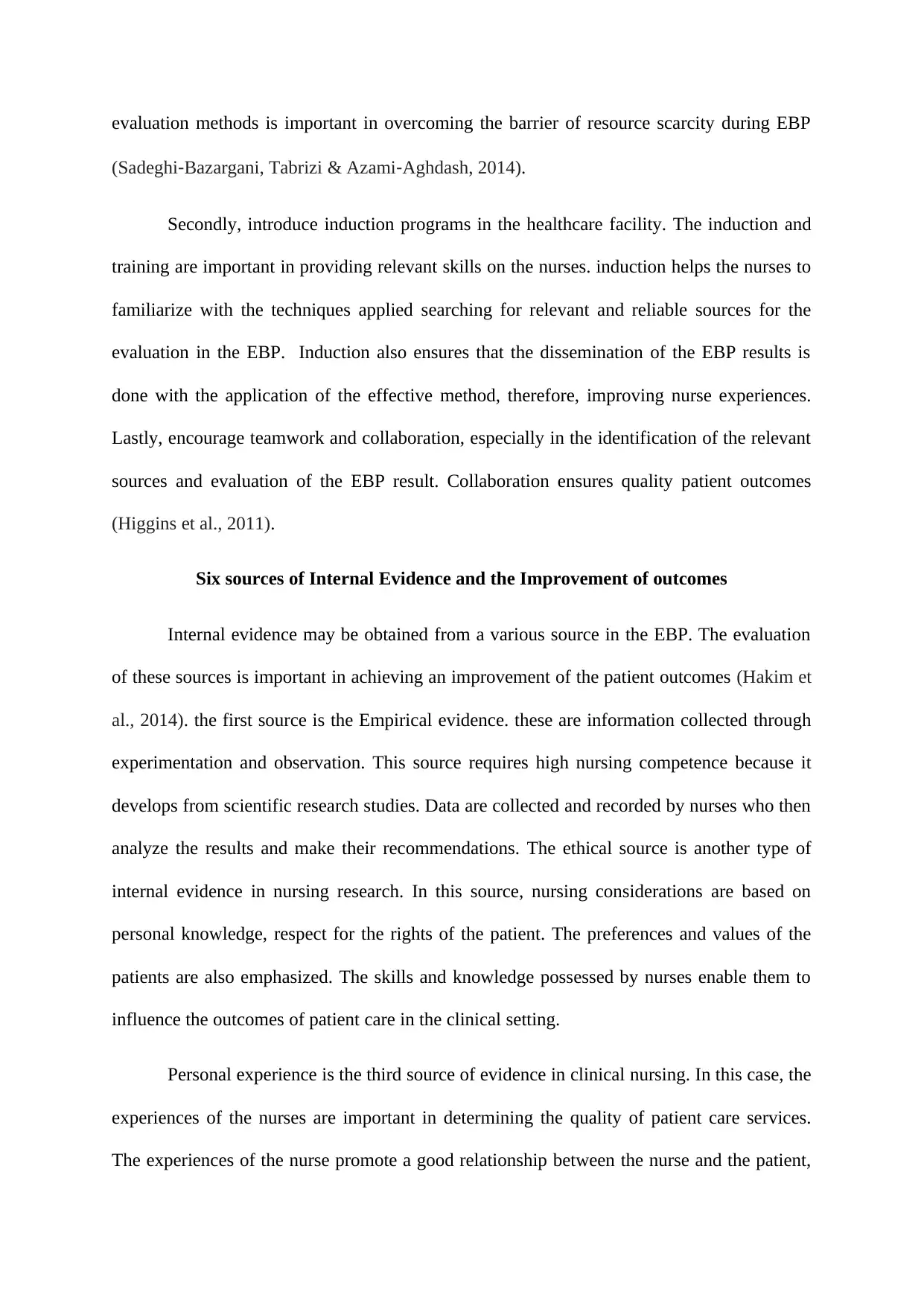
evaluation methods is important in overcoming the barrier of resource scarcity during EBP
(Sadeghi‐Bazargani, Tabrizi & Azami‐Aghdash, 2014).
Secondly, introduce induction programs in the healthcare facility. The induction and
training are important in providing relevant skills on the nurses. induction helps the nurses to
familiarize with the techniques applied searching for relevant and reliable sources for the
evaluation in the EBP. Induction also ensures that the dissemination of the EBP results is
done with the application of the effective method, therefore, improving nurse experiences.
Lastly, encourage teamwork and collaboration, especially in the identification of the relevant
sources and evaluation of the EBP result. Collaboration ensures quality patient outcomes
(Higgins et al., 2011).
Six sources of Internal Evidence and the Improvement of outcomes
Internal evidence may be obtained from a various source in the EBP. The evaluation
of these sources is important in achieving an improvement of the patient outcomes (Hakim et
al., 2014). the first source is the Empirical evidence. these are information collected through
experimentation and observation. This source requires high nursing competence because it
develops from scientific research studies. Data are collected and recorded by nurses who then
analyze the results and make their recommendations. The ethical source is another type of
internal evidence in nursing research. In this source, nursing considerations are based on
personal knowledge, respect for the rights of the patient. The preferences and values of the
patients are also emphasized. The skills and knowledge possessed by nurses enable them to
influence the outcomes of patient care in the clinical setting.
Personal experience is the third source of evidence in clinical nursing. In this case, the
experiences of the nurses are important in determining the quality of patient care services.
The experiences of the nurse promote a good relationship between the nurse and the patient,
(Sadeghi‐Bazargani, Tabrizi & Azami‐Aghdash, 2014).
Secondly, introduce induction programs in the healthcare facility. The induction and
training are important in providing relevant skills on the nurses. induction helps the nurses to
familiarize with the techniques applied searching for relevant and reliable sources for the
evaluation in the EBP. Induction also ensures that the dissemination of the EBP results is
done with the application of the effective method, therefore, improving nurse experiences.
Lastly, encourage teamwork and collaboration, especially in the identification of the relevant
sources and evaluation of the EBP result. Collaboration ensures quality patient outcomes
(Higgins et al., 2011).
Six sources of Internal Evidence and the Improvement of outcomes
Internal evidence may be obtained from a various source in the EBP. The evaluation
of these sources is important in achieving an improvement of the patient outcomes (Hakim et
al., 2014). the first source is the Empirical evidence. these are information collected through
experimentation and observation. This source requires high nursing competence because it
develops from scientific research studies. Data are collected and recorded by nurses who then
analyze the results and make their recommendations. The ethical source is another type of
internal evidence in nursing research. In this source, nursing considerations are based on
personal knowledge, respect for the rights of the patient. The preferences and values of the
patients are also emphasized. The skills and knowledge possessed by nurses enable them to
influence the outcomes of patient care in the clinical setting.
Personal experience is the third source of evidence in clinical nursing. In this case, the
experiences of the nurses are important in determining the quality of patient care services.
The experiences of the nurse promote a good relationship between the nurse and the patient,
Paraphrase This Document
Need a fresh take? Get an instant paraphrase of this document with our AI Paraphraser
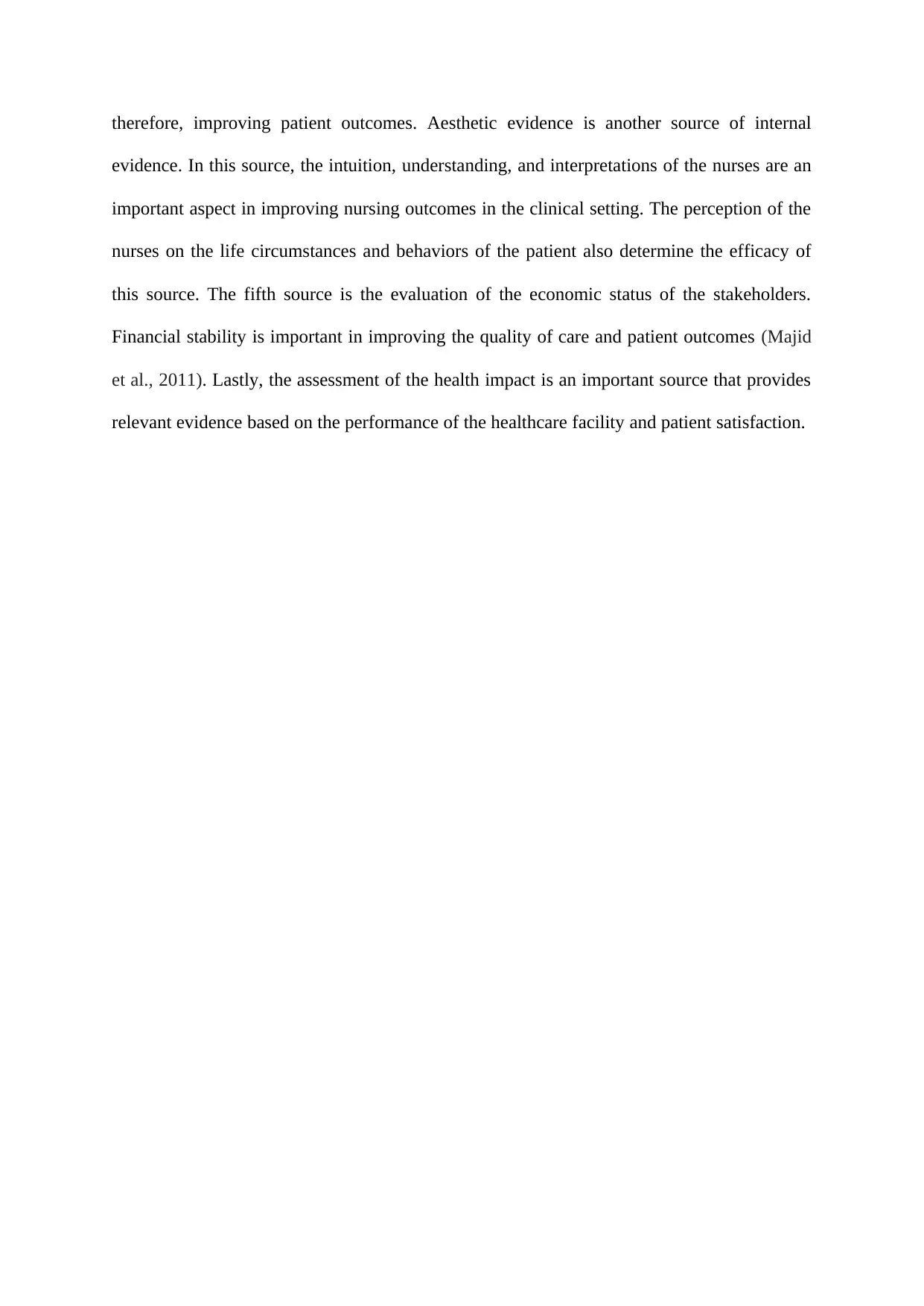
therefore, improving patient outcomes. Aesthetic evidence is another source of internal
evidence. In this source, the intuition, understanding, and interpretations of the nurses are an
important aspect in improving nursing outcomes in the clinical setting. The perception of the
nurses on the life circumstances and behaviors of the patient also determine the efficacy of
this source. The fifth source is the evaluation of the economic status of the stakeholders.
Financial stability is important in improving the quality of care and patient outcomes (Majid
et al., 2011). Lastly, the assessment of the health impact is an important source that provides
relevant evidence based on the performance of the healthcare facility and patient satisfaction.
evidence. In this source, the intuition, understanding, and interpretations of the nurses are an
important aspect in improving nursing outcomes in the clinical setting. The perception of the
nurses on the life circumstances and behaviors of the patient also determine the efficacy of
this source. The fifth source is the evaluation of the economic status of the stakeholders.
Financial stability is important in improving the quality of care and patient outcomes (Majid
et al., 2011). Lastly, the assessment of the health impact is an important source that provides
relevant evidence based on the performance of the healthcare facility and patient satisfaction.
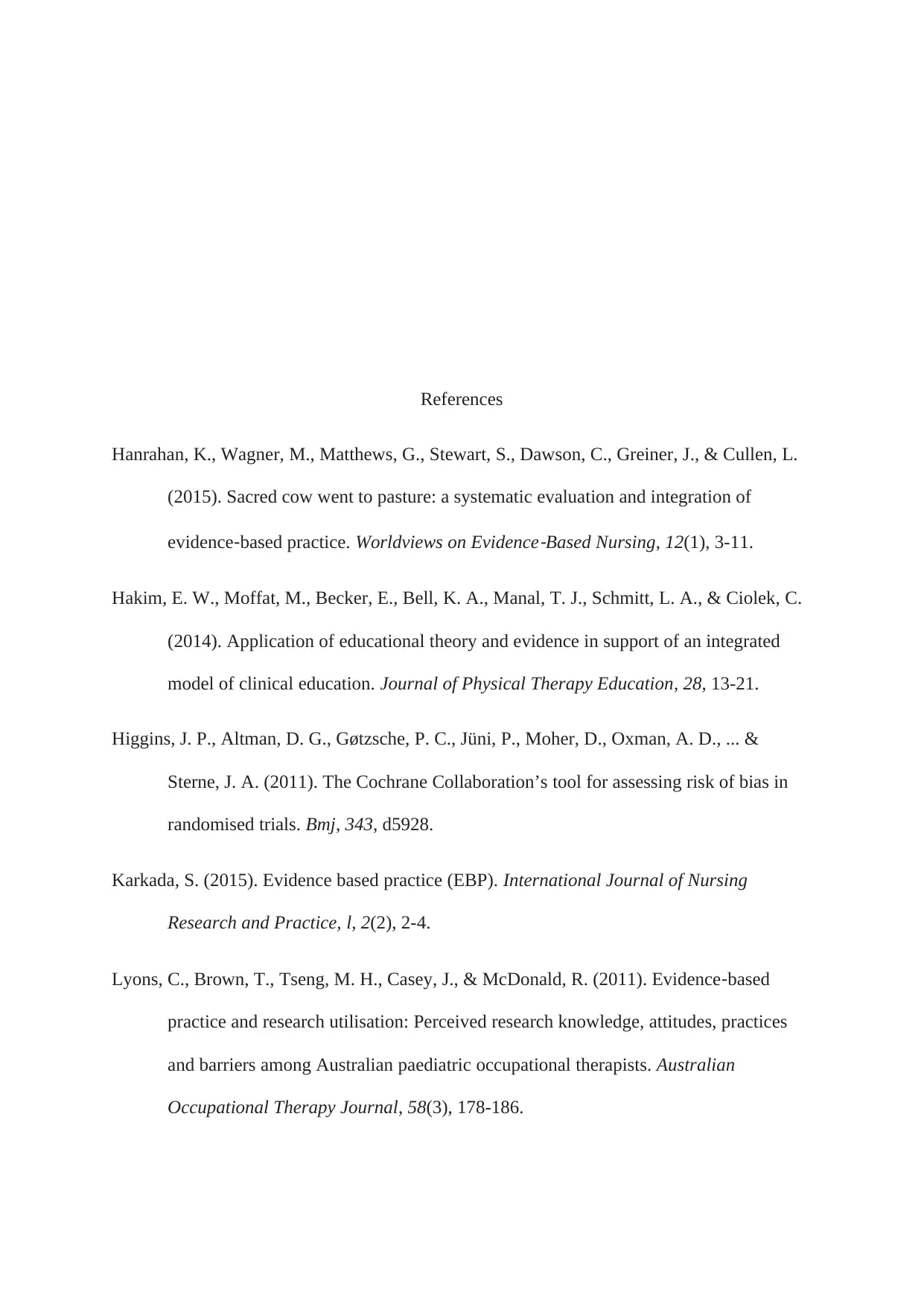
References
Hanrahan, K., Wagner, M., Matthews, G., Stewart, S., Dawson, C., Greiner, J., & Cullen, L.
(2015). Sacred cow went to pasture: a systematic evaluation and integration of
evidence‐based practice. Worldviews on Evidence
‐Based Nursing, 12(1), 3-11.
Hakim, E. W., Moffat, M., Becker, E., Bell, K. A., Manal, T. J., Schmitt, L. A., & Ciolek, C.
(2014). Application of educational theory and evidence in support of an integrated
model of clinical education. Journal of Physical Therapy Education, 28, 13-21.
Higgins, J. P., Altman, D. G., Gøtzsche, P. C., Jüni, P., Moher, D., Oxman, A. D., ... &
Sterne, J. A. (2011). The Cochrane Collaboration’s tool for assessing risk of bias in
randomised trials. Bmj, 343, d5928.
Karkada, S. (2015). Evidence based practice (EBP). International Journal of Nursing
Research and Practice, l, 2(2), 2-4.
Lyons, C., Brown, T., Tseng, M. H., Casey, J., & McDonald, R. (2011). Evidence‐based
practice and research utilisation: Perceived research knowledge, attitudes, practices
and barriers among Australian paediatric occupational therapists. Australian
Occupational Therapy Journal, 58(3), 178-186.
Hanrahan, K., Wagner, M., Matthews, G., Stewart, S., Dawson, C., Greiner, J., & Cullen, L.
(2015). Sacred cow went to pasture: a systematic evaluation and integration of
evidence‐based practice. Worldviews on Evidence
‐Based Nursing, 12(1), 3-11.
Hakim, E. W., Moffat, M., Becker, E., Bell, K. A., Manal, T. J., Schmitt, L. A., & Ciolek, C.
(2014). Application of educational theory and evidence in support of an integrated
model of clinical education. Journal of Physical Therapy Education, 28, 13-21.
Higgins, J. P., Altman, D. G., Gøtzsche, P. C., Jüni, P., Moher, D., Oxman, A. D., ... &
Sterne, J. A. (2011). The Cochrane Collaboration’s tool for assessing risk of bias in
randomised trials. Bmj, 343, d5928.
Karkada, S. (2015). Evidence based practice (EBP). International Journal of Nursing
Research and Practice, l, 2(2), 2-4.
Lyons, C., Brown, T., Tseng, M. H., Casey, J., & McDonald, R. (2011). Evidence‐based
practice and research utilisation: Perceived research knowledge, attitudes, practices
and barriers among Australian paediatric occupational therapists. Australian
Occupational Therapy Journal, 58(3), 178-186.
⊘ This is a preview!⊘
Do you want full access?
Subscribe today to unlock all pages.

Trusted by 1+ million students worldwide
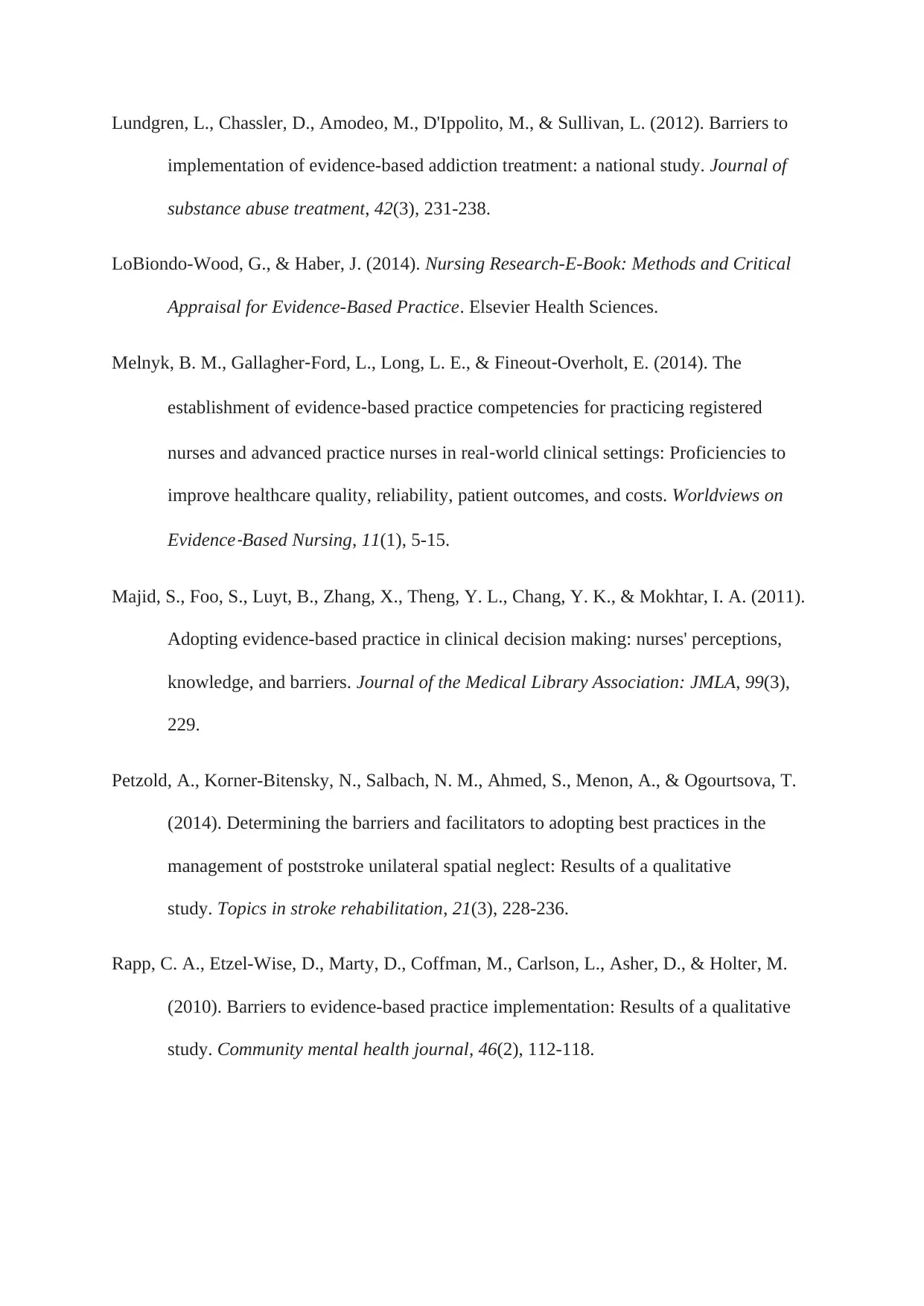
Lundgren, L., Chassler, D., Amodeo, M., D'Ippolito, M., & Sullivan, L. (2012). Barriers to
implementation of evidence-based addiction treatment: a national study. Journal of
substance abuse treatment, 42(3), 231-238.
LoBiondo-Wood, G., & Haber, J. (2014). Nursing Research-E-Book: Methods and Critical
Appraisal for Evidence-Based Practice. Elsevier Health Sciences.
Melnyk, B. M., Gallagher‐Ford, L., Long, L. E., & Fineout‐Overholt, E. (2014). The
establishment of evidence‐based practice competencies for practicing registered
nurses and advanced practice nurses in real‐world clinical settings: Proficiencies to
improve healthcare quality, reliability, patient outcomes, and costs. Worldviews on
Evidence
‐Based Nursing, 11(1), 5-15.
Majid, S., Foo, S., Luyt, B., Zhang, X., Theng, Y. L., Chang, Y. K., & Mokhtar, I. A. (2011).
Adopting evidence-based practice in clinical decision making: nurses' perceptions,
knowledge, and barriers. Journal of the Medical Library Association: JMLA, 99(3),
229.
Petzold, A., Korner-Bitensky, N., Salbach, N. M., Ahmed, S., Menon, A., & Ogourtsova, T.
(2014). Determining the barriers and facilitators to adopting best practices in the
management of poststroke unilateral spatial neglect: Results of a qualitative
study. Topics in stroke rehabilitation, 21(3), 228-236.
Rapp, C. A., Etzel-Wise, D., Marty, D., Coffman, M., Carlson, L., Asher, D., & Holter, M.
(2010). Barriers to evidence-based practice implementation: Results of a qualitative
study. Community mental health journal, 46(2), 112-118.
implementation of evidence-based addiction treatment: a national study. Journal of
substance abuse treatment, 42(3), 231-238.
LoBiondo-Wood, G., & Haber, J. (2014). Nursing Research-E-Book: Methods and Critical
Appraisal for Evidence-Based Practice. Elsevier Health Sciences.
Melnyk, B. M., Gallagher‐Ford, L., Long, L. E., & Fineout‐Overholt, E. (2014). The
establishment of evidence‐based practice competencies for practicing registered
nurses and advanced practice nurses in real‐world clinical settings: Proficiencies to
improve healthcare quality, reliability, patient outcomes, and costs. Worldviews on
Evidence
‐Based Nursing, 11(1), 5-15.
Majid, S., Foo, S., Luyt, B., Zhang, X., Theng, Y. L., Chang, Y. K., & Mokhtar, I. A. (2011).
Adopting evidence-based practice in clinical decision making: nurses' perceptions,
knowledge, and barriers. Journal of the Medical Library Association: JMLA, 99(3),
229.
Petzold, A., Korner-Bitensky, N., Salbach, N. M., Ahmed, S., Menon, A., & Ogourtsova, T.
(2014). Determining the barriers and facilitators to adopting best practices in the
management of poststroke unilateral spatial neglect: Results of a qualitative
study. Topics in stroke rehabilitation, 21(3), 228-236.
Rapp, C. A., Etzel-Wise, D., Marty, D., Coffman, M., Carlson, L., Asher, D., & Holter, M.
(2010). Barriers to evidence-based practice implementation: Results of a qualitative
study. Community mental health journal, 46(2), 112-118.
Paraphrase This Document
Need a fresh take? Get an instant paraphrase of this document with our AI Paraphraser
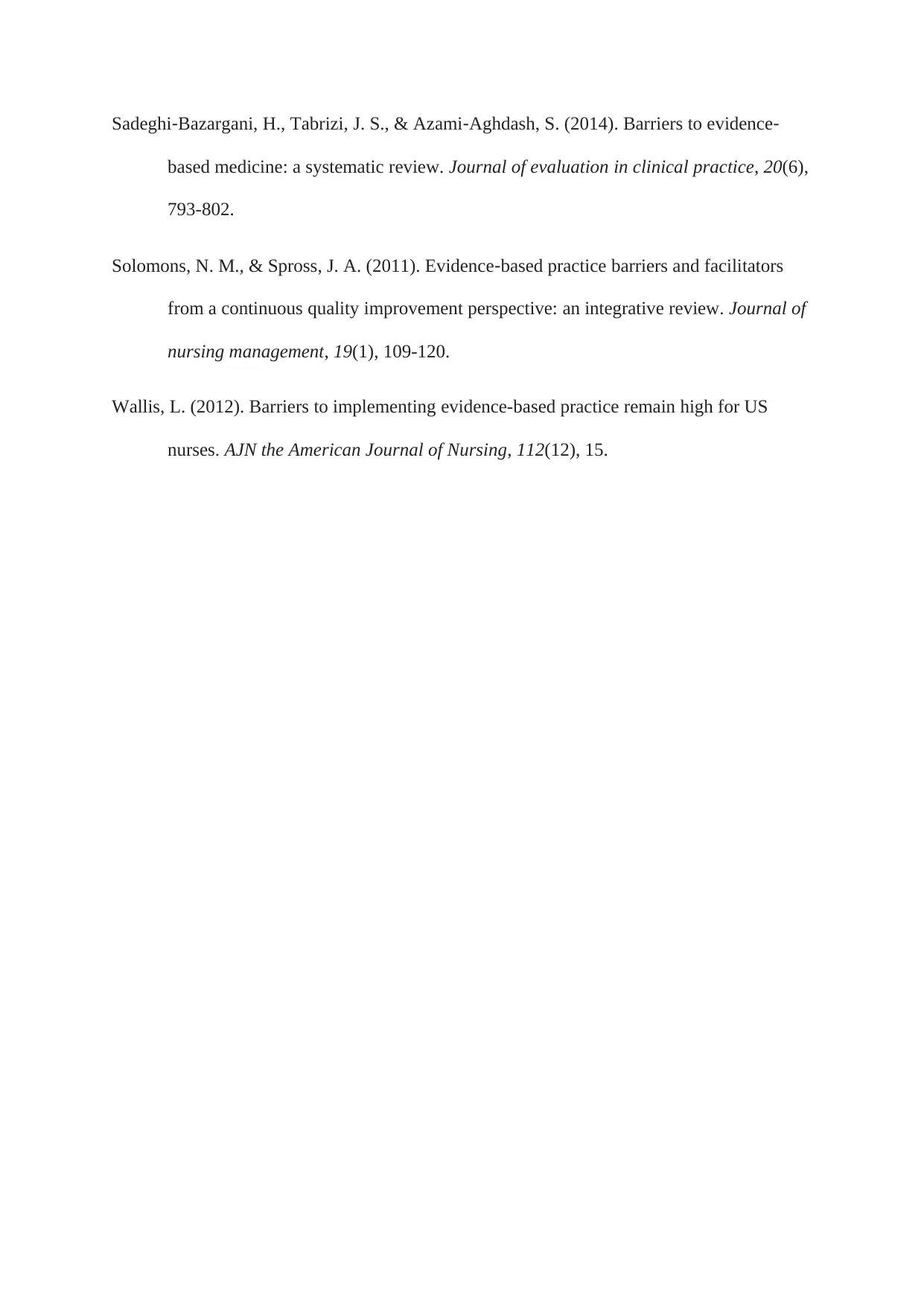
Sadeghi‐Bazargani, H., Tabrizi, J. S., & Azami‐Aghdash, S. (2014). Barriers to evidence‐
based medicine: a systematic review. Journal of evaluation in clinical practice, 20(6),
793-802.
Solomons, N. M., & Spross, J. A. (2011). Evidence‐based practice barriers and facilitators
from a continuous quality improvement perspective: an integrative review. Journal of
nursing management, 19(1), 109-120.
Wallis, L. (2012). Barriers to implementing evidence-based practice remain high for US
nurses. AJN the American Journal of Nursing, 112(12), 15.
based medicine: a systematic review. Journal of evaluation in clinical practice, 20(6),
793-802.
Solomons, N. M., & Spross, J. A. (2011). Evidence‐based practice barriers and facilitators
from a continuous quality improvement perspective: an integrative review. Journal of
nursing management, 19(1), 109-120.
Wallis, L. (2012). Barriers to implementing evidence-based practice remain high for US
nurses. AJN the American Journal of Nursing, 112(12), 15.
1 out of 11
Related Documents
Your All-in-One AI-Powered Toolkit for Academic Success.
+13062052269
info@desklib.com
Available 24*7 on WhatsApp / Email
![[object Object]](/_next/static/media/star-bottom.7253800d.svg)
Unlock your academic potential
Copyright © 2020–2025 A2Z Services. All Rights Reserved. Developed and managed by ZUCOL.





